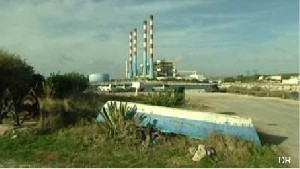Liquid chlorine (Cl2) leaked out inside an industrial gas plant during air pressure drainage of a railcar. The previous day at 2 pm, 2 experienced technicians connected a Cl2 railcar in accordance with the procedure entitled “Railcar acceptance/hook-up”, consisting of: removing the fixed installation/railcar flanges; positioning both the grip clip on the railcar liquid valve and the high-pressure “inflation” air (HP) inlet on the car’s gas valve; then clamping the flanges. Between 3 and 4 pm, technicians installed air inlets on the railcar valves, opened the manual valves on the low-pressure (LP) network, alkali tested the seal on the grip clip – railcar junction, and detected a Cl2 leak. In failing to activate the emergency shutdown as planned, one of the technicians closed the car’s liquid valve out of reflex in using the closest air control valve. The installation automatically switched into safe operating mode. Two technicians wearing self-breathing apparatuses retightened the flange and stopped the leak. The liquid Cl2 piping was drained, degassed into bleach tanks and then inerted by opening the railcar’s HP inflation air network. The compressors were shut down and technicians scheduled to change the flange joint the following morning.
At 7:30 the next morning, the liquid Cl2 line leaving the railcar was depressurised prior to disassembling the grip clip. The Cl2 was routed to the soda lye / bleach neutralisation tanks. In noticing frost on the tanks’ degassing rods at 9:30 am, the workshop manager verified that the “liquid Cl2” valve on the railcar was indeed closed; he had the safety locknut removed on the control rod and noted that the rod had partially risen and that liquid Cl2 was circulating. The valve closed entirely when he activated the air inlet valve, which served to bleed the circuit. Around 9:35, the manager observed a Cl2 leak on the HP inflation air network, forming a first puddle in the packaging shop. Making his way to the compressor room to isolate the air network, he discovered a second puddle near an air dryer.
The internal emergency plan was triggered at 9:45 am. An emergency response team verified the site’s confinement as well as operations at the neutralising tower. Plant personnel were required to remain indoors. A second team installed water curtains. At 10 am, fire-fighters established a safety perimeter and a control post, all road/motorway access were blocked, and neighbouring firms closed their premises. No trace of Cl2 was recorded around the property boundary. Media outlets arrived at the scene. The site underwent cleaning from 10 am to 9:45 pm, at which time the emergency plan was lifted; 25 kg of Cl2 trapped in the HP inflation air pipeline were lost.
Three factors enabled the liquid Cl2 to rise into the HP air network: 1) inappropriate response by the technician the previous day by closing the railcar’s liquid valve; 2) pressure drop during a longer than scheduled air inerting due to partial opening of the car’s liquid valve (resulting from an inadequate air network design); and 3) an inoperable differential pressure-based safety system dP due to handling error. The safe operating mode initiated by the Cl2 detection on 26th May had caused the cut-off valve to close; its reopening required resetting the dP system in the workshop; however, technicians did not perform this reset and instead used both manual bypasses on the dP valve.
On 29th May, an order imposed maintaining the installations offline while awaiting the operator’s report on accident causes and implementation of compensatory measures such as: update, revision or creation of safety management system (SMS) procedures in order to supervise the suspected operations through appropriate technician training; installation of 3-channel manual valves on the LP air network controlled upstream of instrumentation for the purpose of bleeding the car’s valve air inlet and avoiding an untimely (due to reflex action) air valve closure; (reversible) blocking of the dP safety bypass, to solely be used during facility maintenance (padlocked manual valves); separation of the high-pressure process / inflation air networks with one compressor each so as to avoid disturbances between the 2 networks as well as to increase the insufficient air supply capacities; and lastly the installation of 2 “liquid trap” buffer tanks on both these networks.
Other measures were planned for subsequent phases: expanded Cl2 detection network to cover, among other areas, the compressor room; introduction of a Cl2 detection system on both high-pressure process / inflation compressed air networks with valve closure servo controls in the event of detection; installation of an air extraction duct in the compressor room connected to the neutralising tower; periodic controls of technician training programme efficiency (with the SMS procedure); and SMS-based supervision of safety bypass use conditions.
Download the detailed report in .pdf format (309 Kb)





